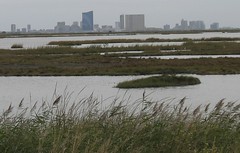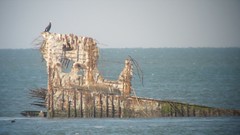Some more old Jersey bird names from Trumbull's Names and Portraits of Birds Which Interest Gunners.... These are from Atlantic City which, given that Trumbull's book was published in 1888, looked a little different than it does today.
Big Yellow-legged Plover - Greater Yellowlegs
Black-breast - Dunlin
Blaten Duck - Gadwall
Bog Snipe - Wilson's Snipe
Brant-bird - Dunlin
Bull-head - Black-bellied Plover
Calico-back - Ruddy Turnstone
Cock-robin - Hooded Merganser
Cock-robin Duck - Hooded Merganser
Cub-head - Common Goldeneye
Granny - Long-tailed Duck
Gray-back - Short-billed Dowitcher
Hay-bird - Pectoral Sandpiper
Hollow-head - Black-bellied Plover
Horse-foot Marlin - Whimbrel
Long-neck - Northern Pintail
Mud-hen - Clapper Rail
Old Granny - Long-tailed Duck
Ring-tailed Marlin - Hudsonian Godwit
Sleepy Broad-bill - Ruddy Duck
Small Yellow-legged Plover - Lesser Yellowlegs
Spoon-bill - Northern Shoveller
Sprig-tail - Northern Pintail
Straight-billed Curlew - Marbled Godwit
Telltale - Greater Yellowlegs, Lesser Yellowlegs
Triddler - Pectoral Sandpiper
Winter Snipe - Dunlin
Previously in this series:
Jersey Game Bird Names 1
Barnegat Bird Names
Tuckerton Bird Names
Cape May City Bird Names
A calendar of noteworthy occurrences in New Jersey birding history, such as first state records. Also ruminations on documentation, sources, and historical matters, plus the occasional off-topic post or moth photo.
Thursday, June 10, 2010
Tuesday, June 08, 2010
The Concrete Ship
On this day in 1926, a storm hit Cape May. A concrete ship hulk, which had been intended to find its final harbor as part of a ferry dock, broke away from its moorings in the storm and ran aground not far off Sunset Beach. The ship could not be salvaged afterward and has been crumbling into the sea ever since.
Though the idea of a concrete ship seems to defy the laws of physics, a number of these vessels were built during World War I and II. The S. S. Atlantus was seaworthy enough to bring troops home from Europe and transport coal in New England after she left her home port of Brunswick, Georgia, in December 1918. She was retired in 1920, only to be resurrected by the prospect of a ferry service connecting Cape May with Delaware. Then the storm put paid to that notion. It wasn't until 1964 that Cape May-Lewes ferry service finally became a reality.
After the S. S. Atlantus ran aground, she became a curiosity for tourists and a landmark for birders. The concrete ship took her place among the birding topography of Cape May along with the bunker, the magnesite plant, and the beanery. She became known as a good place for a seawatch, and a good spot for Great Cormorant, Purple Sandpiper, or staging migrant Red-throated Loons (in the appropriate season). Unfortunately, she continues to decay into the bay; I guess it's a mark of the time that I've spent birding that the concrete ship is obviously reduced from what she was when I first met her.
For lots more about concrete ships in general, see the concrete ships site. The S. S. Atlantus is also given her own page there. For the stop-and-go history of ferry service between Cape May and Delaware, see the history page on the official Cape May-Lewes ferry site.
Rest in peace, S. S. Atlantus. We'll miss you when you're gone.
Though the idea of a concrete ship seems to defy the laws of physics, a number of these vessels were built during World War I and II. The S. S. Atlantus was seaworthy enough to bring troops home from Europe and transport coal in New England after she left her home port of Brunswick, Georgia, in December 1918. She was retired in 1920, only to be resurrected by the prospect of a ferry service connecting Cape May with Delaware. Then the storm put paid to that notion. It wasn't until 1964 that Cape May-Lewes ferry service finally became a reality.
After the S. S. Atlantus ran aground, she became a curiosity for tourists and a landmark for birders. The concrete ship took her place among the birding topography of Cape May along with the bunker, the magnesite plant, and the beanery. She became known as a good place for a seawatch, and a good spot for Great Cormorant, Purple Sandpiper, or staging migrant Red-throated Loons (in the appropriate season). Unfortunately, she continues to decay into the bay; I guess it's a mark of the time that I've spent birding that the concrete ship is obviously reduced from what she was when I first met her.
For lots more about concrete ships in general, see the concrete ships site. The S. S. Atlantus is also given her own page there. For the stop-and-go history of ferry service between Cape May and Delaware, see the history page on the official Cape May-Lewes ferry site.
Rest in peace, S. S. Atlantus. We'll miss you when you're gone.
Subscribe to:
Posts (Atom)

